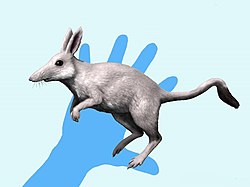| Polydolopimorphia Temporal range: | |
|---|---|
 | |
| Argyrolagus palmeri | |
| Scientific classification | |
| Kingdom: | Animalia |
| Phylum: | Chordata |
| Class: | Mammalia |
| Clade: | Metatheria |
| Clade: | Marsupialiformes |
| Order: | † Polydolopimorphia Archer, 1984 |
| Subgroups | |
Polydolopimorphia is an extinct order of metatherians, closely related to extant marsupials. Known from the Paleocene-Pliocene of South America and the Eocene of Antarctica, they were a diverse group during the Paleogene, filling many niches, before declining and becoming extinct at the end of the Neogene. [1] It is divided into two suborders, Bonapartheriiformes, and Polydolopiformes [2] Most members are only known from jaw fragments, which have their characteristically generally bunodont teeth. [3] The morphology of their teeth has led to proposals that polydolopimorphians may be crown group marsupials, nested within Australidelphia, [4] though this proposal, has been questioned, with other analyses finding them outside of crown-group Marsupialia. [3] The monophyly of the group has been questioned, due to the possibility of the characteristic bunodont teeth emerging convergently in unrelated groups, rather than reflecting a true phylogenetic relationship. [5] The group contained omnivorous, frugivorous and herbivorous forms. [4]



